BAO6714 ERP Report: Adoption, SOX, and Case Studies
VerifiedAdded on 2020/03/03
|20
|3628
|18
Report
AI Summary
This report provides a comprehensive analysis of Enterprise Resource Planning (ERP) systems. It begins by discussing the core functions of ERP and explores the reasons behind its adoption by businesses, including operational efficiency, accuracy, consistency, mobility, and enhanced customer satisfaction. The report supports these reasons with relevant statistics on ERP usage and market trends. It then delves into the Sarbanes-Oxley Act (SOX) and its implications for companies, particularly focusing on how SAP has adapted to meet SOX requirements. The report presents case studies of companies that have successfully implemented SAP, such as Cadbury, and those that have failed, like Hershey's, analyzing the factors contributing to their respective outcomes. The report concludes with a summary of key findings and insights into the evolving landscape of ERP systems and their impact on business operations.
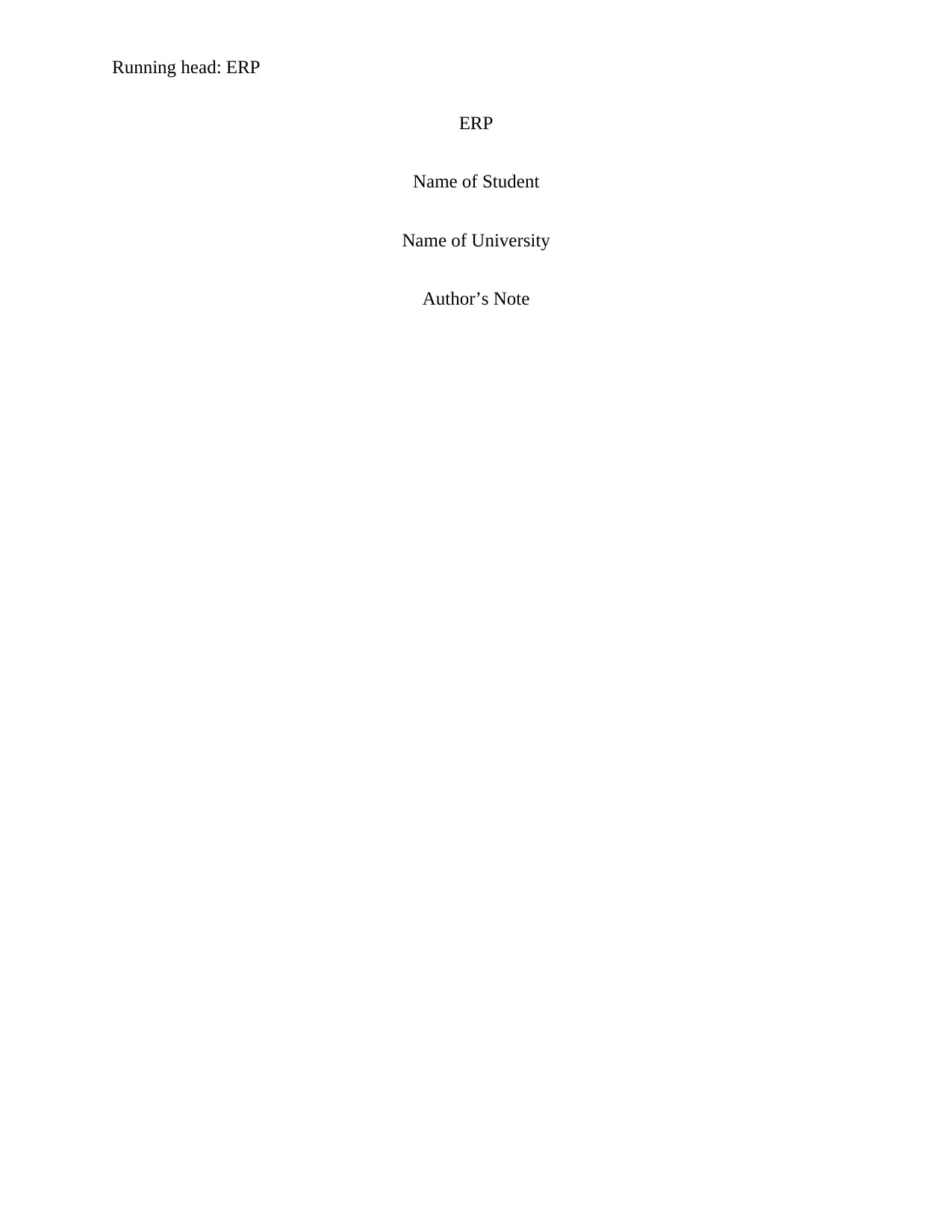
Running head: ERP
ERP
Name of Student
Name of University
Author’s Note
ERP
Name of Student
Name of University
Author’s Note
Paraphrase This Document
Need a fresh take? Get an instant paraphrase of this document with our AI Paraphraser
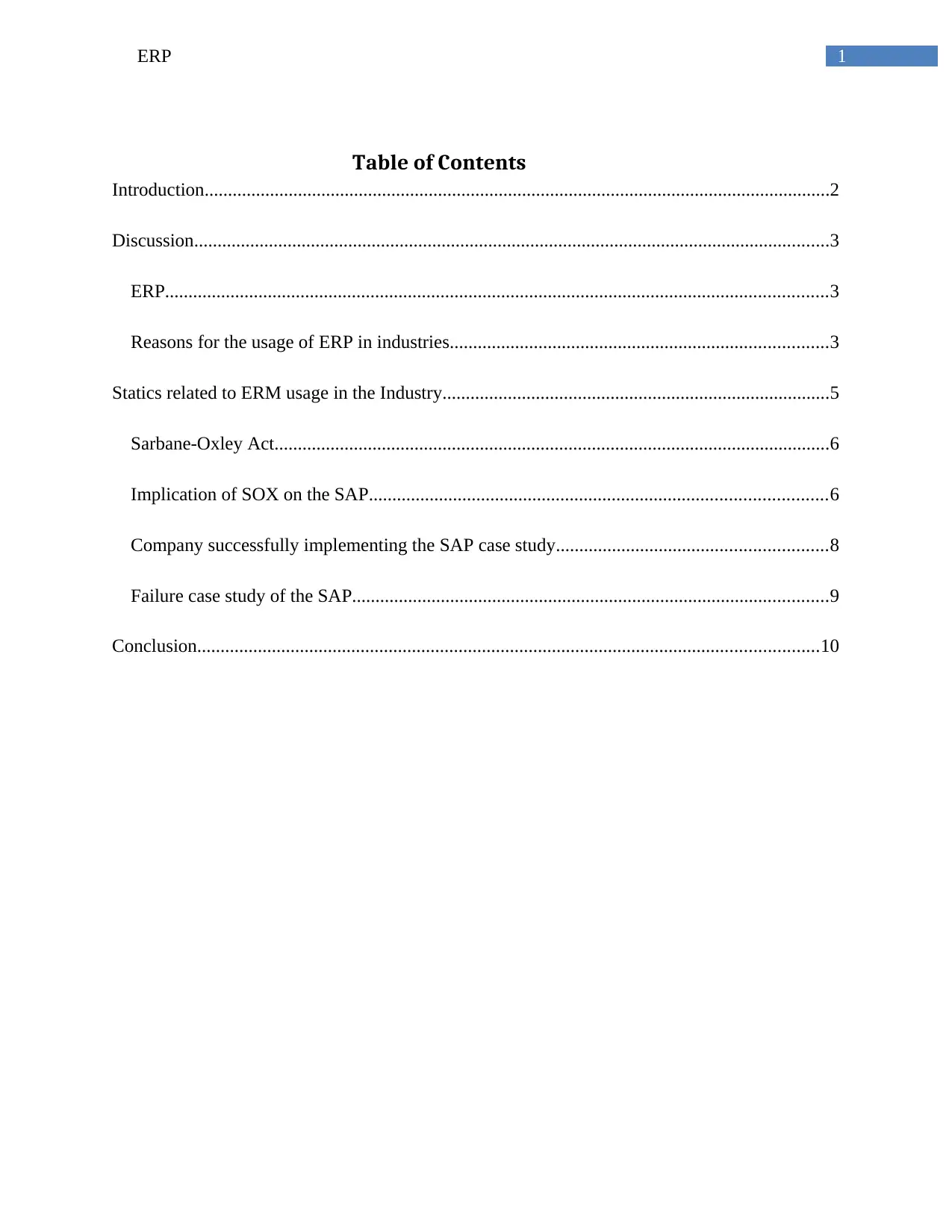
1ERP
Table of Contents
Introduction......................................................................................................................................2
Discussion........................................................................................................................................3
ERP..............................................................................................................................................3
Reasons for the usage of ERP in industries.................................................................................3
Statics related to ERM usage in the Industry...................................................................................5
Sarbane-Oxley Act.......................................................................................................................6
Implication of SOX on the SAP..................................................................................................6
Company successfully implementing the SAP case study..........................................................8
Failure case study of the SAP......................................................................................................9
Conclusion.....................................................................................................................................10
Table of Contents
Introduction......................................................................................................................................2
Discussion........................................................................................................................................3
ERP..............................................................................................................................................3
Reasons for the usage of ERP in industries.................................................................................3
Statics related to ERM usage in the Industry...................................................................................5
Sarbane-Oxley Act.......................................................................................................................6
Implication of SOX on the SAP..................................................................................................6
Company successfully implementing the SAP case study..........................................................8
Failure case study of the SAP......................................................................................................9
Conclusion.....................................................................................................................................10
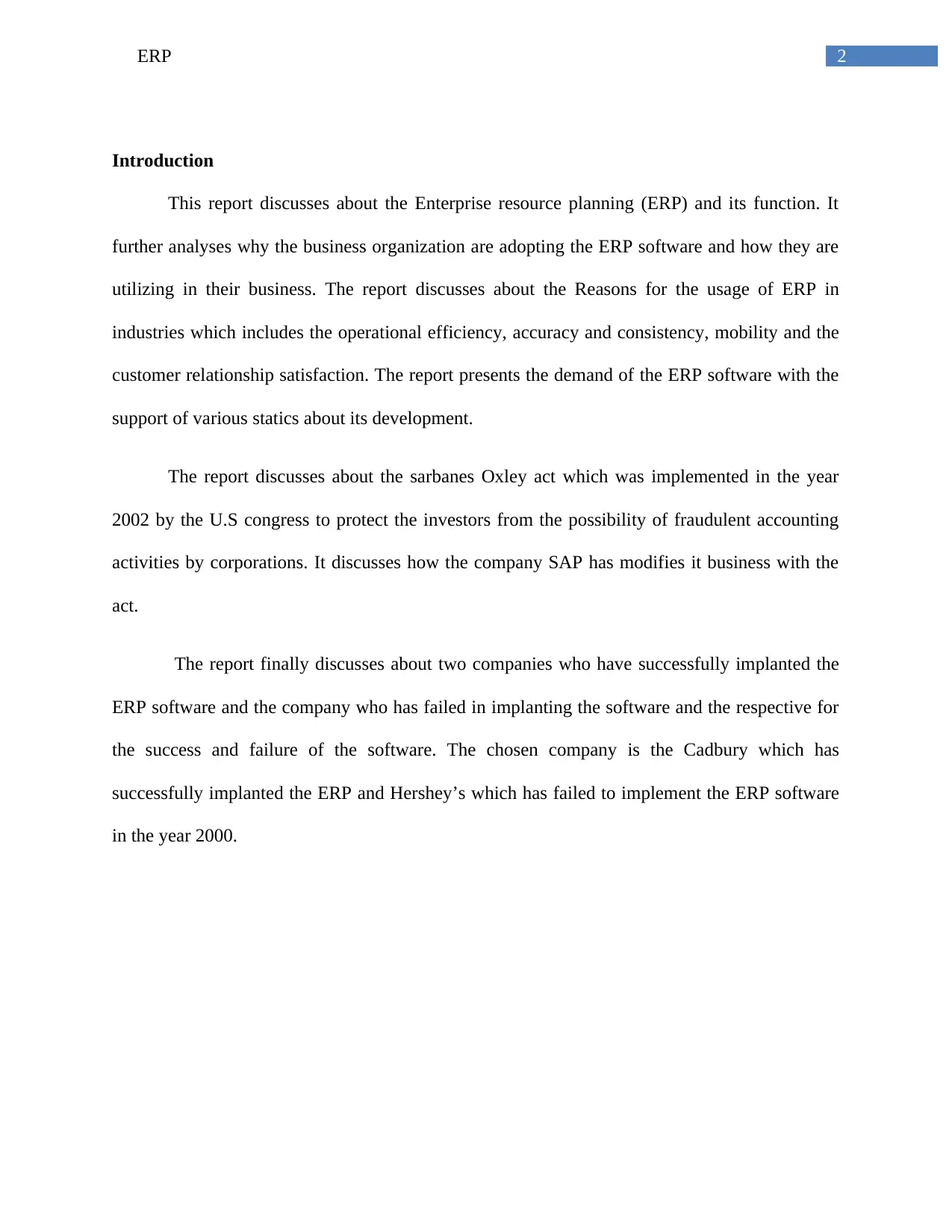
2ERP
Introduction
This report discusses about the Enterprise resource planning (ERP) and its function. It
further analyses why the business organization are adopting the ERP software and how they are
utilizing in their business. The report discusses about the Reasons for the usage of ERP in
industries which includes the operational efficiency, accuracy and consistency, mobility and the
customer relationship satisfaction. The report presents the demand of the ERP software with the
support of various statics about its development.
The report discusses about the sarbanes Oxley act which was implemented in the year
2002 by the U.S congress to protect the investors from the possibility of fraudulent accounting
activities by corporations. It discusses how the company SAP has modifies it business with the
act.
The report finally discusses about two companies who have successfully implanted the
ERP software and the company who has failed in implanting the software and the respective for
the success and failure of the software. The chosen company is the Cadbury which has
successfully implanted the ERP and Hershey’s which has failed to implement the ERP software
in the year 2000.
Introduction
This report discusses about the Enterprise resource planning (ERP) and its function. It
further analyses why the business organization are adopting the ERP software and how they are
utilizing in their business. The report discusses about the Reasons for the usage of ERP in
industries which includes the operational efficiency, accuracy and consistency, mobility and the
customer relationship satisfaction. The report presents the demand of the ERP software with the
support of various statics about its development.
The report discusses about the sarbanes Oxley act which was implemented in the year
2002 by the U.S congress to protect the investors from the possibility of fraudulent accounting
activities by corporations. It discusses how the company SAP has modifies it business with the
act.
The report finally discusses about two companies who have successfully implanted the
ERP software and the company who has failed in implanting the software and the respective for
the success and failure of the software. The chosen company is the Cadbury which has
successfully implanted the ERP and Hershey’s which has failed to implement the ERP software
in the year 2000.
⊘ This is a preview!⊘
Do you want full access?
Subscribe today to unlock all pages.

Trusted by 1+ million students worldwide
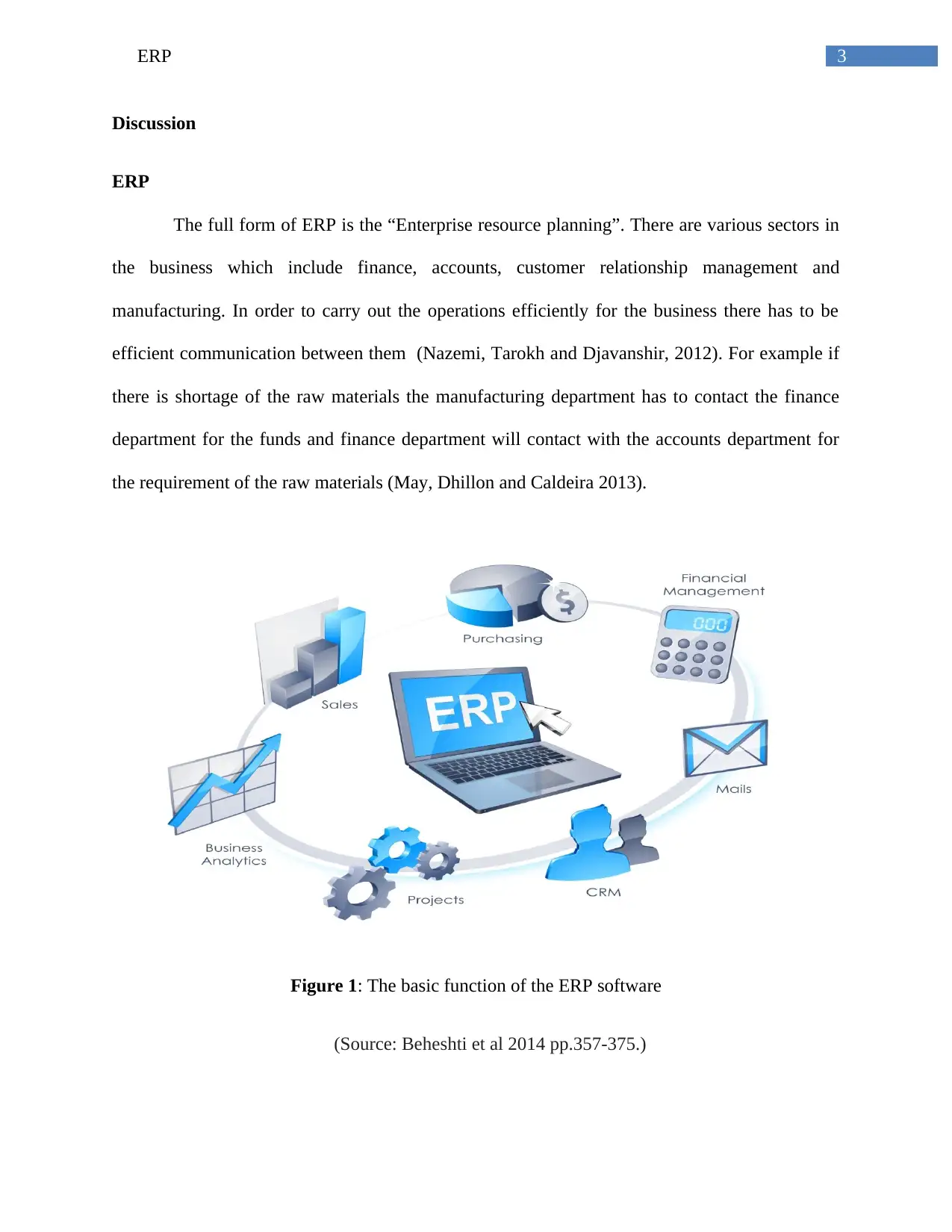
3ERP
Discussion
ERP
The full form of ERP is the “Enterprise resource planning”. There are various sectors in
the business which include finance, accounts, customer relationship management and
manufacturing. In order to carry out the operations efficiently for the business there has to be
efficient communication between them (Nazemi, Tarokh and Djavanshir, 2012). For example if
there is shortage of the raw materials the manufacturing department has to contact the finance
department for the funds and finance department will contact with the accounts department for
the requirement of the raw materials (May, Dhillon and Caldeira 2013).
Figure 1: The basic function of the ERP software
(Source: Beheshti et al 2014 pp.357-375.)
Discussion
ERP
The full form of ERP is the “Enterprise resource planning”. There are various sectors in
the business which include finance, accounts, customer relationship management and
manufacturing. In order to carry out the operations efficiently for the business there has to be
efficient communication between them (Nazemi, Tarokh and Djavanshir, 2012). For example if
there is shortage of the raw materials the manufacturing department has to contact the finance
department for the funds and finance department will contact with the accounts department for
the requirement of the raw materials (May, Dhillon and Caldeira 2013).
Figure 1: The basic function of the ERP software
(Source: Beheshti et al 2014 pp.357-375.)
Paraphrase This Document
Need a fresh take? Get an instant paraphrase of this document with our AI Paraphraser

4ERP
Thus from the example it can be implied all the department of the company is involve for the
single operation, in order to integrate all the department under one software for efficient
exchange of data is the major and principle function of the ERP software. ERP function can be
used in various application of the business. Various reason can be enlisted which is responsible
for the usage of ERP applications.
Reasons for the usage of ERP in industries
The operational efficiency
If an organization is small with approx 30-50 employees then it is easy to manage the operations,
control and monitor the various operations, but in the case of company which has over thousands
of employee there will be thousands of operation which will be implemented simultaneously, in
order to track and maintain records of all these operation and it is the huge challenge for the
company, if there is mismanagement of even a single operation all other operation of the
company will be effected which will affect the productivity of the company (Ram, Corkindale,
and Wu 2013). Therefore to overcome such situation, ERP software is used as it has the ability to
monitor them and track the operations. As the result it reduces the overhead and operating
expenses.
The accuracy and consistency
The ERP software not only manages the operation but also stores them in consistent and accurate
form. In large and medium scale industry where over hundreds are working in a single
department, it might happen that each of them have different views thus providing different
solution to the common problem to the mange ( Beheshti et al. 2014).As the results confusion
Thus from the example it can be implied all the department of the company is involve for the
single operation, in order to integrate all the department under one software for efficient
exchange of data is the major and principle function of the ERP software. ERP function can be
used in various application of the business. Various reason can be enlisted which is responsible
for the usage of ERP applications.
Reasons for the usage of ERP in industries
The operational efficiency
If an organization is small with approx 30-50 employees then it is easy to manage the operations,
control and monitor the various operations, but in the case of company which has over thousands
of employee there will be thousands of operation which will be implemented simultaneously, in
order to track and maintain records of all these operation and it is the huge challenge for the
company, if there is mismanagement of even a single operation all other operation of the
company will be effected which will affect the productivity of the company (Ram, Corkindale,
and Wu 2013). Therefore to overcome such situation, ERP software is used as it has the ability to
monitor them and track the operations. As the result it reduces the overhead and operating
expenses.
The accuracy and consistency
The ERP software not only manages the operation but also stores them in consistent and accurate
form. In large and medium scale industry where over hundreds are working in a single
department, it might happen that each of them have different views thus providing different
solution to the common problem to the mange ( Beheshti et al. 2014).As the results confusion

5ERP
can be created which can lead to the wrong decision for the operation. Therefore installing ERP
will ensure that all the solution of the respective employees are store in accurate and consistent
way so that each solution can be monitored to implement.
The concept of the mobility
The concept of the mobility means that to carry out the business operation from anywhere.
Nowadays mobility in the business is on the high demand with the increasing competition
(Bradford 2015).
Figure 2: The mobility function of the ERP
(Source: Ruivo, Oliveira and Neto 2014 pp.166-184)
can be created which can lead to the wrong decision for the operation. Therefore installing ERP
will ensure that all the solution of the respective employees are store in accurate and consistent
way so that each solution can be monitored to implement.
The concept of the mobility
The concept of the mobility means that to carry out the business operation from anywhere.
Nowadays mobility in the business is on the high demand with the increasing competition
(Bradford 2015).
Figure 2: The mobility function of the ERP
(Source: Ruivo, Oliveira and Neto 2014 pp.166-184)
⊘ This is a preview!⊘
Do you want full access?
Subscribe today to unlock all pages.

Trusted by 1+ million students worldwide

6ERP
The executives do not want their employees to restrict their office work only to their offices, in
order to increase the productivity they should also work apart from the office residence. The ERP
software has the mobility feature which enables to access to their companies related information
and to implement them without a corporate network system provides significant improvements to
productivity service quality and an increased competitive advantage.
Enables better customer satisfaction
The application of the ERP can be used for better customer satisfaction if the customer has
certain queries (Ruivo, Oliveira and Neto 2014) as discussed above that ERP system helps in
better management of the data, thus it will help in better management of the customer queries as
the customer representatives have access to the updated and better managed data which can help
them to deal with the customers queries efficiently.
Statics related to ERM usage in the Industry
The ERP software was first used in 1990 by the company named as the Gartner Group
where it was used for the purposed of the material requirement planning (MRP) (Hsu, Yen and
Chung 2015).It application expanded rapidly in 1990. According to the panorama consulting
solutions the 2015 ERP solution report shows that in 2014 over eighty percent of the total
company in the world is using the ERP applications in carrying out their business transactions.
SAP (system application product) is the company whose ERP software is used in most of the
organization.
The executives do not want their employees to restrict their office work only to their offices, in
order to increase the productivity they should also work apart from the office residence. The ERP
software has the mobility feature which enables to access to their companies related information
and to implement them without a corporate network system provides significant improvements to
productivity service quality and an increased competitive advantage.
Enables better customer satisfaction
The application of the ERP can be used for better customer satisfaction if the customer has
certain queries (Ruivo, Oliveira and Neto 2014) as discussed above that ERP system helps in
better management of the data, thus it will help in better management of the customer queries as
the customer representatives have access to the updated and better managed data which can help
them to deal with the customers queries efficiently.
Statics related to ERM usage in the Industry
The ERP software was first used in 1990 by the company named as the Gartner Group
where it was used for the purposed of the material requirement planning (MRP) (Hsu, Yen and
Chung 2015).It application expanded rapidly in 1990. According to the panorama consulting
solutions the 2015 ERP solution report shows that in 2014 over eighty percent of the total
company in the world is using the ERP applications in carrying out their business transactions.
SAP (system application product) is the company whose ERP software is used in most of the
organization.
Paraphrase This Document
Need a fresh take? Get an instant paraphrase of this document with our AI Paraphraser
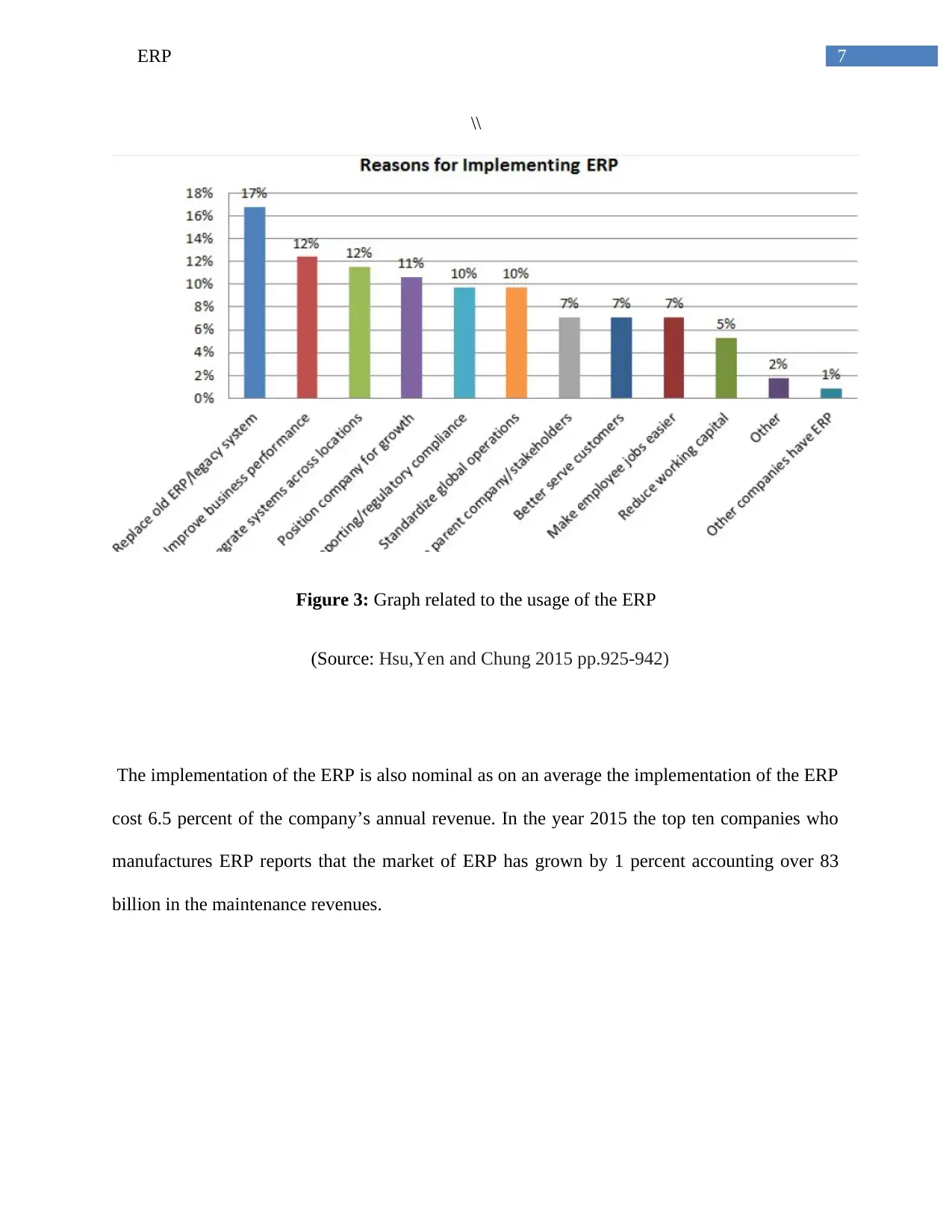
7ERP
\\
Figure 3: Graph related to the usage of the ERP
(Source: Hsu,Yen and Chung 2015 pp.925-942)
The implementation of the ERP is also nominal as on an average the implementation of the ERP
cost 6.5 percent of the company’s annual revenue. In the year 2015 the top ten companies who
manufactures ERP reports that the market of ERP has grown by 1 percent accounting over 83
billion in the maintenance revenues.
\\
Figure 3: Graph related to the usage of the ERP
(Source: Hsu,Yen and Chung 2015 pp.925-942)
The implementation of the ERP is also nominal as on an average the implementation of the ERP
cost 6.5 percent of the company’s annual revenue. In the year 2015 the top ten companies who
manufactures ERP reports that the market of ERP has grown by 1 percent accounting over 83
billion in the maintenance revenues.
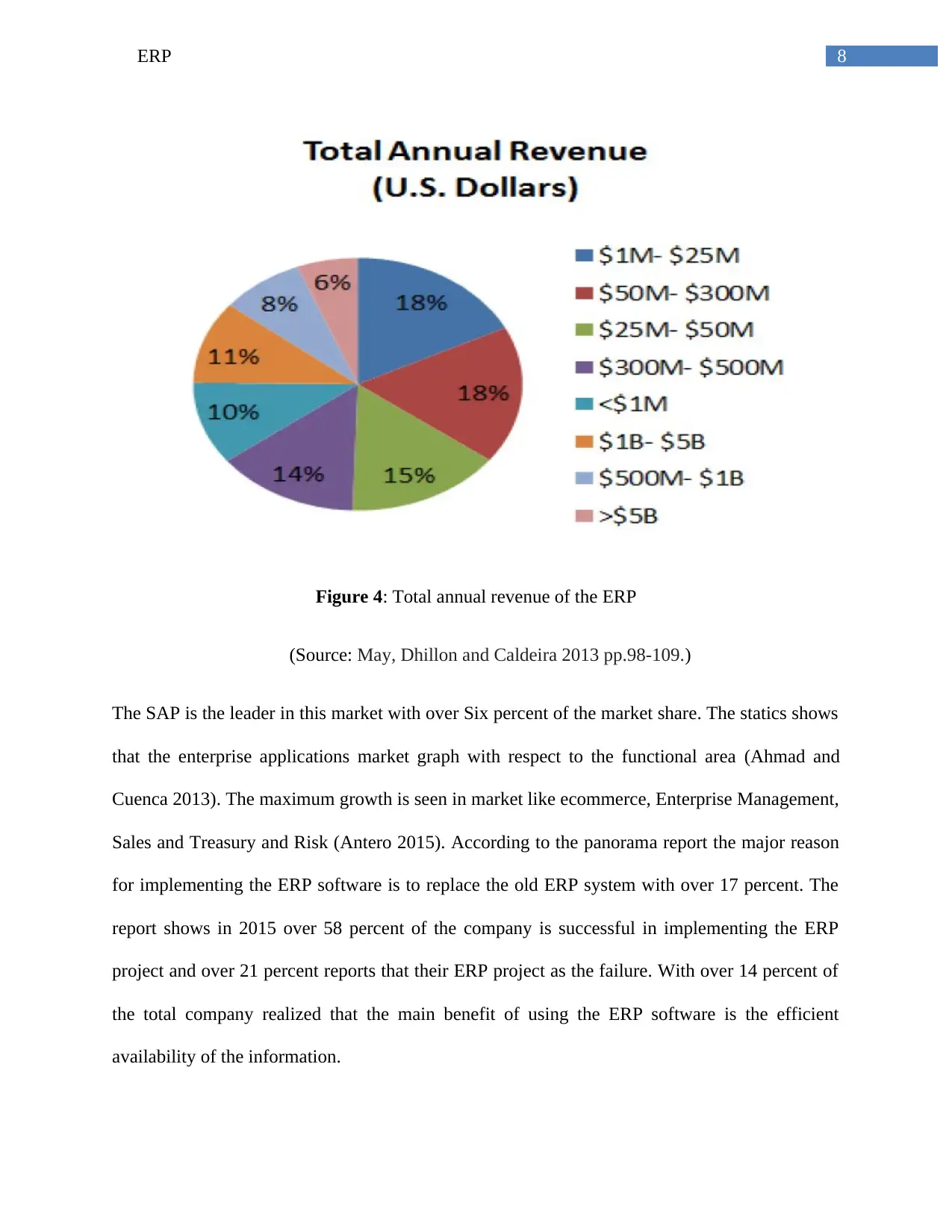
8ERP
Figure 4: Total annual revenue of the ERP
(Source: May, Dhillon and Caldeira 2013 pp.98-109.)
The SAP is the leader in this market with over Six percent of the market share. The statics shows
that the enterprise applications market graph with respect to the functional area (Ahmad and
Cuenca 2013). The maximum growth is seen in market like ecommerce, Enterprise Management,
Sales and Treasury and Risk (Antero 2015). According to the panorama report the major reason
for implementing the ERP software is to replace the old ERP system with over 17 percent. The
report shows in 2015 over 58 percent of the company is successful in implementing the ERP
project and over 21 percent reports that their ERP project as the failure. With over 14 percent of
the total company realized that the main benefit of using the ERP software is the efficient
availability of the information.
Figure 4: Total annual revenue of the ERP
(Source: May, Dhillon and Caldeira 2013 pp.98-109.)
The SAP is the leader in this market with over Six percent of the market share. The statics shows
that the enterprise applications market graph with respect to the functional area (Ahmad and
Cuenca 2013). The maximum growth is seen in market like ecommerce, Enterprise Management,
Sales and Treasury and Risk (Antero 2015). According to the panorama report the major reason
for implementing the ERP software is to replace the old ERP system with over 17 percent. The
report shows in 2015 over 58 percent of the company is successful in implementing the ERP
project and over 21 percent reports that their ERP project as the failure. With over 14 percent of
the total company realized that the main benefit of using the ERP software is the efficient
availability of the information.
⊘ This is a preview!⊘
Do you want full access?
Subscribe today to unlock all pages.

Trusted by 1+ million students worldwide
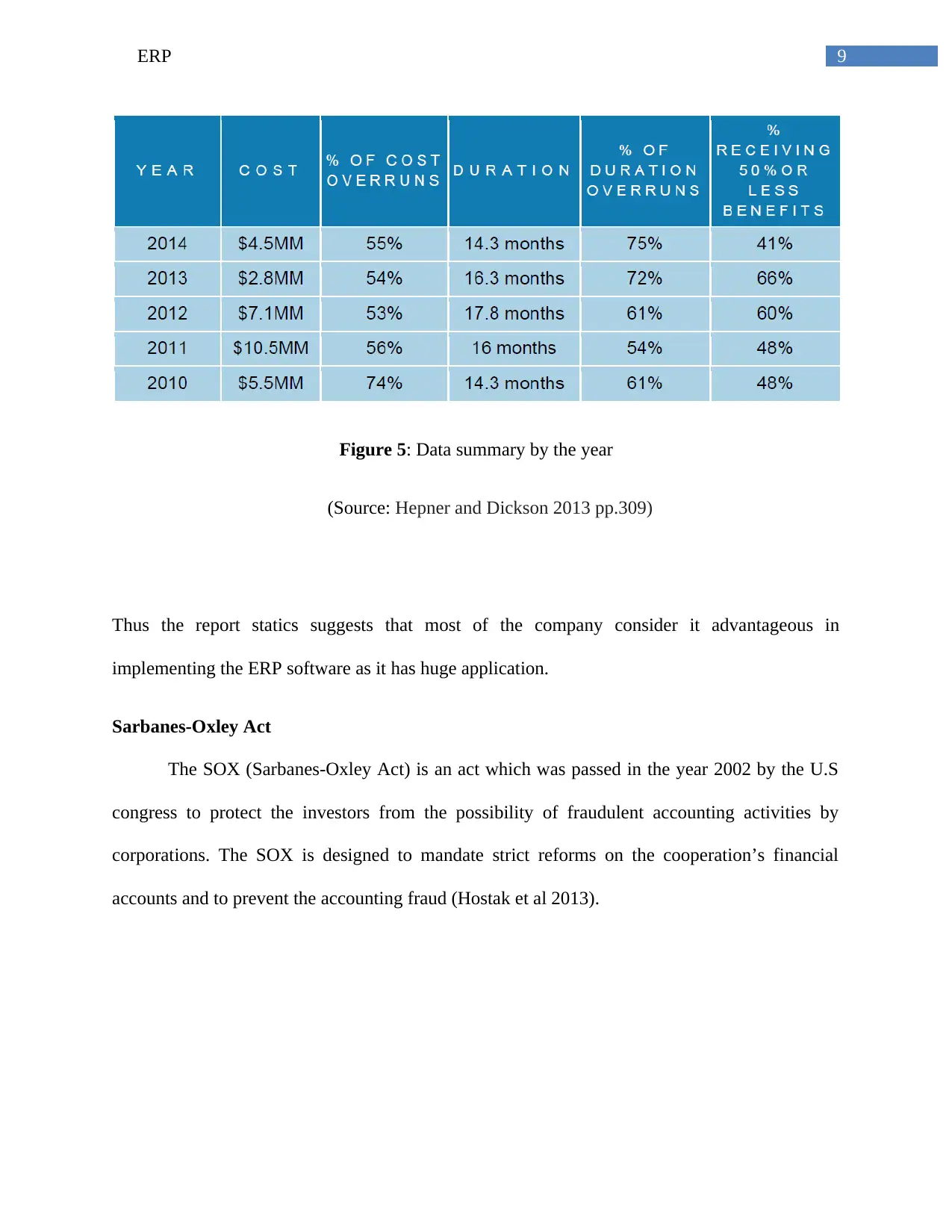
9ERP
Figure 5: Data summary by the year
(Source: Hepner and Dickson 2013 pp.309)
Thus the report statics suggests that most of the company consider it advantageous in
implementing the ERP software as it has huge application.
Sarbanes-Oxley Act
The SOX (Sarbanes-Oxley Act) is an act which was passed in the year 2002 by the U.S
congress to protect the investors from the possibility of fraudulent accounting activities by
corporations. The SOX is designed to mandate strict reforms on the cooperation’s financial
accounts and to prevent the accounting fraud (Hostak et al 2013).
Figure 5: Data summary by the year
(Source: Hepner and Dickson 2013 pp.309)
Thus the report statics suggests that most of the company consider it advantageous in
implementing the ERP software as it has huge application.
Sarbanes-Oxley Act
The SOX (Sarbanes-Oxley Act) is an act which was passed in the year 2002 by the U.S
congress to protect the investors from the possibility of fraudulent accounting activities by
corporations. The SOX is designed to mandate strict reforms on the cooperation’s financial
accounts and to prevent the accounting fraud (Hostak et al 2013).
Paraphrase This Document
Need a fresh take? Get an instant paraphrase of this document with our AI Paraphraser
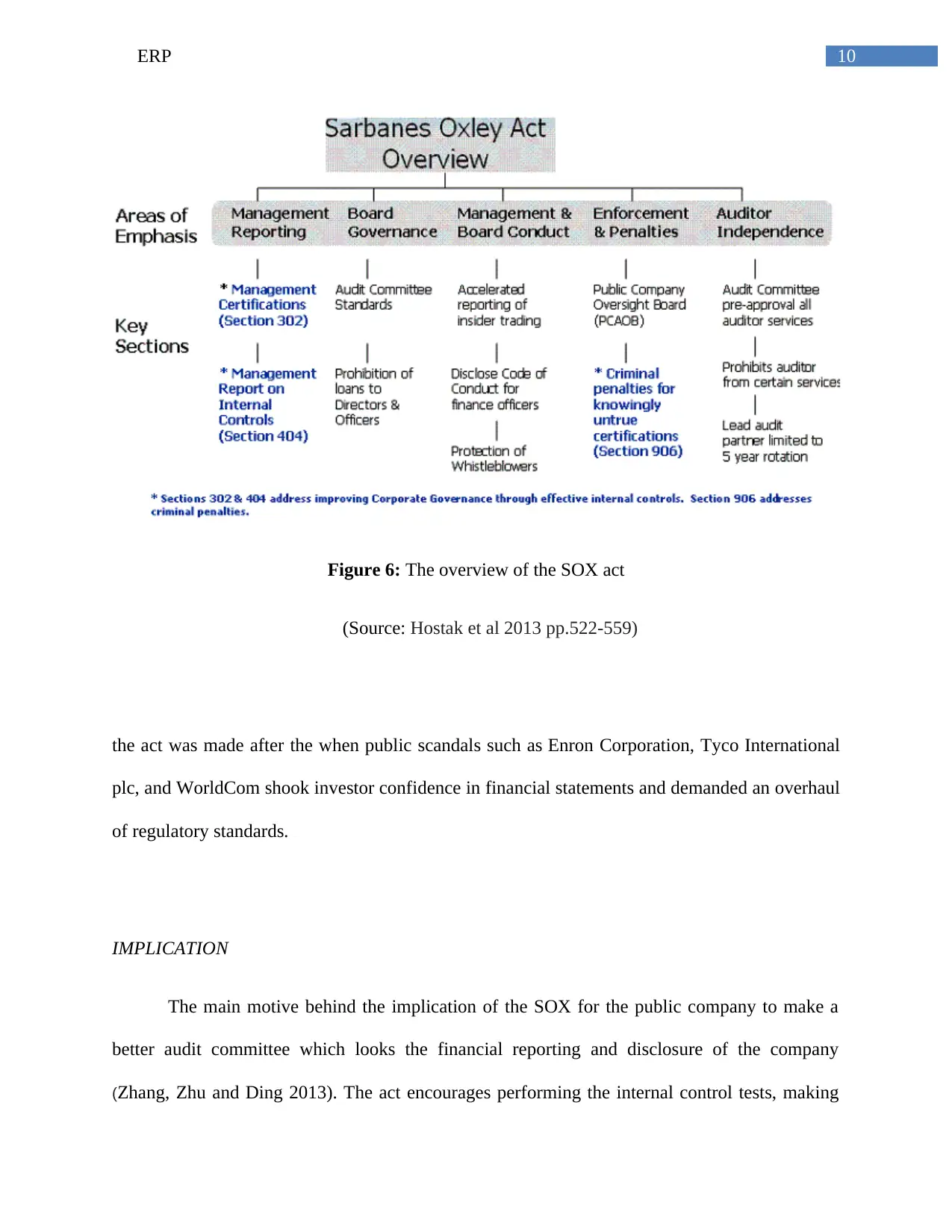
10ERP
Figure 6: The overview of the SOX act
(Source: Hostak et al 2013 pp.522-559)
the act was made after the when public scandals such as Enron Corporation, Tyco International
plc, and WorldCom shook investor confidence in financial statements and demanded an overhaul
of regulatory standards.
IMPLICATION
The main motive behind the implication of the SOX for the public company to make a
better audit committee which looks the financial reporting and disclosure of the company
(Zhang, Zhu and Ding 2013). The act encourages performing the internal control tests, making
Figure 6: The overview of the SOX act
(Source: Hostak et al 2013 pp.522-559)
the act was made after the when public scandals such as Enron Corporation, Tyco International
plc, and WorldCom shook investor confidence in financial statements and demanded an overhaul
of regulatory standards.
IMPLICATION
The main motive behind the implication of the SOX for the public company to make a
better audit committee which looks the financial reporting and disclosure of the company
(Zhang, Zhu and Ding 2013). The act encourages performing the internal control tests, making

11ERP
the directors and officers responsible to bring accuracy in the financial statements of the
company (Calderon, Wang and Conrad 2012). If any company is accounted for the mishandling
on the accounts statements then there are strict criminal penalties on the following company on
the fraudulent charge against the company.
Implication of SOX on the SAP
The implication of the Sarbanes-Oxley Act is also adopted by the SAP software which
makes its customer to approach the company from both the perspective of business and
technology (Dapkutė 2013). The main goal of the SOX act is to bring transparency and accuracy
and also enhances the speed for having trusted financial statements and ensures trusted
accounting.
The SAP company is made up with various in built controls which, when utilized properly, will
provide the tools which is required to aid the executives assistance for the data processing and
the internal controls (Badua, Sharifi and Watkins 2012). The SAP contains the modules like
Management of Internal Controls, Enhanced Audit tools and “Whistle-Blowing” functionality to
comply with SOX rules and regulation. In the purchasing world it is the key factor of the
software named “my SAP” which stands for the Supplier Relationship Management (my SAP
SRM) which will provide the key areas of support (Blount et al . 2016). Below is the few ways
how SAP can work for better security in the presence of SOX rules:
To provide the information access to the user on what is there need to do and need to
know
To secure all the transaction which takes place, programs and tables
The access to the SAP R/3 should be authorized and approved properly
the directors and officers responsible to bring accuracy in the financial statements of the
company (Calderon, Wang and Conrad 2012). If any company is accounted for the mishandling
on the accounts statements then there are strict criminal penalties on the following company on
the fraudulent charge against the company.
Implication of SOX on the SAP
The implication of the Sarbanes-Oxley Act is also adopted by the SAP software which
makes its customer to approach the company from both the perspective of business and
technology (Dapkutė 2013). The main goal of the SOX act is to bring transparency and accuracy
and also enhances the speed for having trusted financial statements and ensures trusted
accounting.
The SAP company is made up with various in built controls which, when utilized properly, will
provide the tools which is required to aid the executives assistance for the data processing and
the internal controls (Badua, Sharifi and Watkins 2012). The SAP contains the modules like
Management of Internal Controls, Enhanced Audit tools and “Whistle-Blowing” functionality to
comply with SOX rules and regulation. In the purchasing world it is the key factor of the
software named “my SAP” which stands for the Supplier Relationship Management (my SAP
SRM) which will provide the key areas of support (Blount et al . 2016). Below is the few ways
how SAP can work for better security in the presence of SOX rules:
To provide the information access to the user on what is there need to do and need to
know
To secure all the transaction which takes place, programs and tables
The access to the SAP R/3 should be authorized and approved properly
⊘ This is a preview!⊘
Do you want full access?
Subscribe today to unlock all pages.

Trusted by 1+ million students worldwide
1 out of 20
Related Documents
Your All-in-One AI-Powered Toolkit for Academic Success.
+13062052269
info@desklib.com
Available 24*7 on WhatsApp / Email
![[object Object]](/_next/static/media/star-bottom.7253800d.svg)
Unlock your academic potential
Copyright © 2020–2025 A2Z Services. All Rights Reserved. Developed and managed by ZUCOL.





